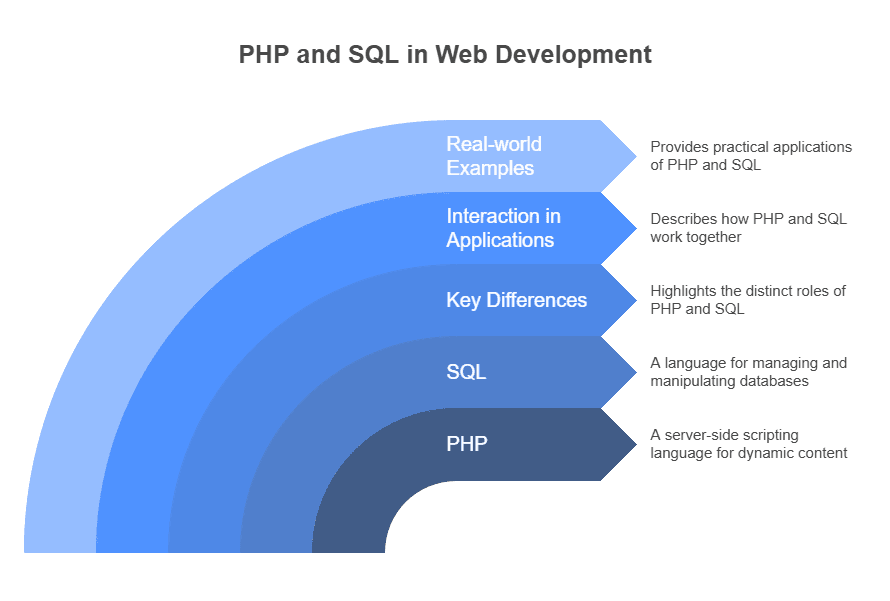This is the podcast of this article.
Introduction
When it comes to web development, two essential technologies often work together: PHP and SQL. While they serve different purposes, they are commonly used in dynamic, database-driven applications.
PHP is a server-side scripting language that enables developers to create interactive web pages, whereas SQL is a query language used to manage and manipulate databases.

Understanding their differences and how they work together is crucial for anyone looking to build efficient and scalable web applications. In this guide, we will explore:
- What is PHP and how does it work?
- What is SQL and why is it important?
- Key differences between PHP and SQL
- How PHP and SQL interact in web applications
- Real-world examples and best practices
By the end of this article, you will have a clear understanding of how these two technologies complement each other in modern web development.
What is PHP?
PHP (Hypertext Preprocessor) is a server-side scripting language designed for web development. It is widely used to create dynamic and interactive websites that respond to user inputs.

Key Features of PHP:
- Server-side Execution: PHP code runs on the web server, generating HTML that is sent to the user’s browser.
- Database Connectivity: PHP interacts with MySQL, PostgreSQL, and other databases to store and retrieve data.
- Cross-Platform Compatibility: Works on Windows, Linux, and macOS.
- Session Management: PHP can manage logins, cookies, and user authentication.
- CMS Integration: Popular content management systems like WordPress, Joomla, and Drupal run on PHP.
Example: How PHP Works in Web Applications
Imagine a user logging into a website:
- The user enters their username and password into a login form.
- PHP processes the input and sends an SQL query to check if the credentials match.
- If valid, PHP creates a session and redirects the user to their profile.
- If incorrect, PHP displays an error message.
PHP acts as the logic controller, handling user interactions, security checks, and content generation.
What is SQL?
SQL (Structured Query Language) is a standardized language used to manage, retrieve, and manipulate data in relational databases. Unlike PHP, SQL does not create web pages but is essential for storing and retrieving data efficiently.

Key Features of SQL:
- Data Management: Used to store, update, delete, and retrieve data.
- Query Execution: SQL allows you to execute commands like SELECT, INSERT, UPDATE, and DELETE.
- Security & Access Control: SQL provides permissions and encryption to secure data.
- Optimized Performance: SQL databases use indexing and relationships to ensure fast queries.
Example: How SQL Works in Web Applications
Using the same login system example:
- The user enters login credentials.
- PHP sends an SQL query to check if the username exists in the database.
- SQL retrieves the stored password for verification.
- PHP uses the result to determine if the login attempt is successful.
SQL acts as the data storage system, while PHP serves as the interface that communicates with it.
Key Differences Between PHP and SQL

| Feature | PHP | SQL |
|---|---|---|
| Purpose | Handles logic and content generation | Manages data storage and retrieval |
| Execution | Runs on a web server | Runs inside a database system |
| Language Type | Scripting language with functions and loops | Query language used for database operations |
| Dependency | Uses SQL queries to access database information | Works independently but is often used with PHP |
| Example Use | Handles user authentication and content generation | Stores and retrieves user data |
How PHP and SQL Work Together in Web Development
In real-world web applications, PHP and SQL collaborate to manage both user interactions and data storage. Here’s how they function together:
- Receiving User Input
PHP collects form data (e.g., login credentials, search queries).
It sanitizes the input to prevent SQL injection attacks. - Querying the Database
PHP sends SQL queries to fetch or update data.
SQL processes the request and returns relevant results. - Displaying Information
PHP processes the retrieved SQL data and converts it into HTML.
The web page updates dynamically with new content.

This combination allows websites to be interactive, data-driven, and user-friendly.
Real-World Applications of PHP and SQL
Many well-known platforms use PHP and SQL together to manage large-scale data operations efficiently:
1. E-Commerce Websites (Amazon, eBay, Shopify)
- PHP: Handles cart management, orders, and payments.
- SQL: Manages inventory, product details, and customer data.
2. Social Media Platforms (Facebook, Twitter, Instagram)
- PHP: Generates feeds, user profiles, and posts dynamically.
- SQL: Stores user data, comments, likes, and interactions.
3. Online Booking & Ticketing (Airbnb, Uber, Eventbrite)
- PHP: Processes user reservations and payments.
- SQL: Stores booking details, available slots, and user history.

Insights from Web Development Experience
From my own experience as a web developer, mastering both PHP and SQL is crucial for building scalable, secure applications.
For instance, while developing an e-commerce website:
- PHP handled: User authentication, cart and checkout logic, order confirmation pages.
- SQL managed: Product inventory, customer details, transaction records.
Key Takeaways:
- Optimized SQL queries improve PHP performance, making websites faster.
- Well-structured PHP code enhances security, preventing SQL injection.
- Learning both PHP and SQL will help you build interactive, data-driven applications efficiently.
Conclusion: Which One Should You Learn?

- If you want to build interactive websites, start with PHP.
- If you need to manage large datasets, focus on SQL.
- For a complete web development skillset, learn both PHP and SQL together.
Final Thought
Rather than competing, PHP and SQL complement each other in web development. PHP provides functionality, while SQL ensures data integrity. By mastering both, you’ll be well-equipped to build powerful, dynamic applications.
PHP is a server-side scripting language used to create dynamic web pages, while SQL is a query language for managing databases. PHP handles user interactions and business logic, whereas SQL stores, retrieves, and manipulates data.
Yes, PHP can function without SQL databases. It can generate dynamic content, process forms, and manage sessions. However, for data storage and retrieval, SQL is commonly used.
SQL injection occurs when attackers manipulate database queries through user inputs, leading to unauthorized access or data manipulation. To prevent this, use prepared statements and parameterized queries.
SQL is easier for beginners as it focuses on database queries, while PHP requires understanding programming concepts like logic, loops, and functions. If you want to build web applications, learning both is beneficial.
Yes, PHP powers platforms like WordPress, and SQL remains the standard for relational databases. Both are widely used in web development due to their efficiency, scalability, and extensive support.


